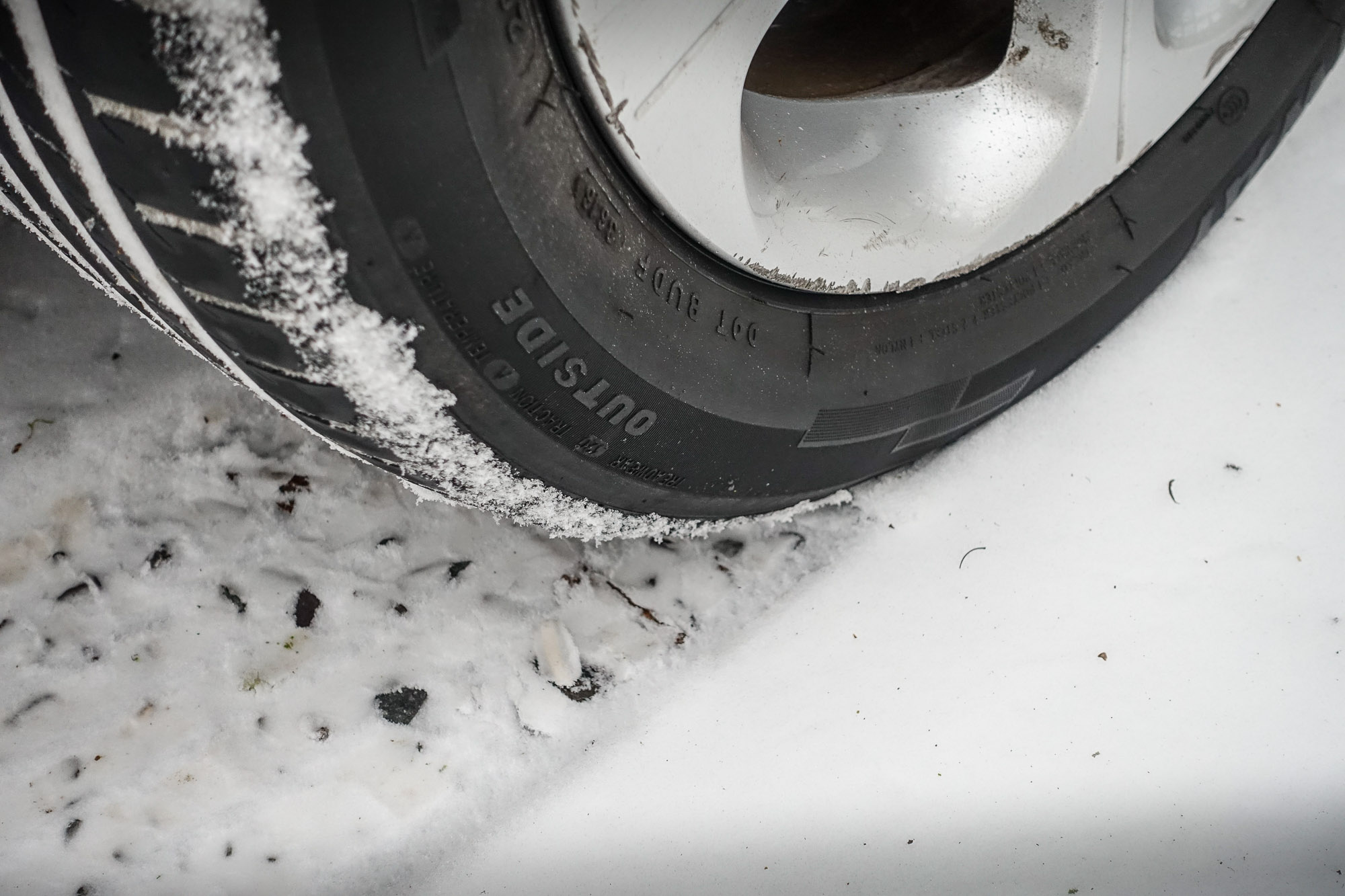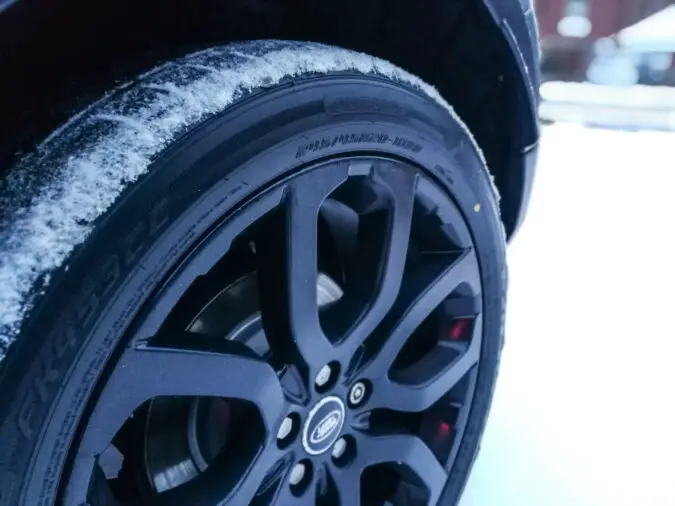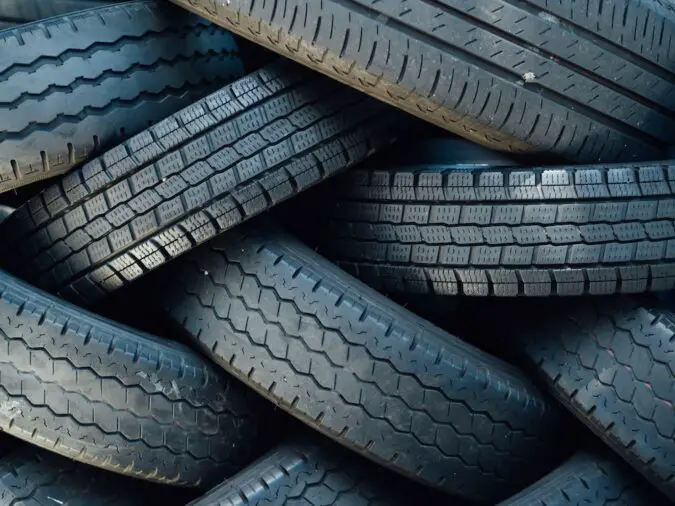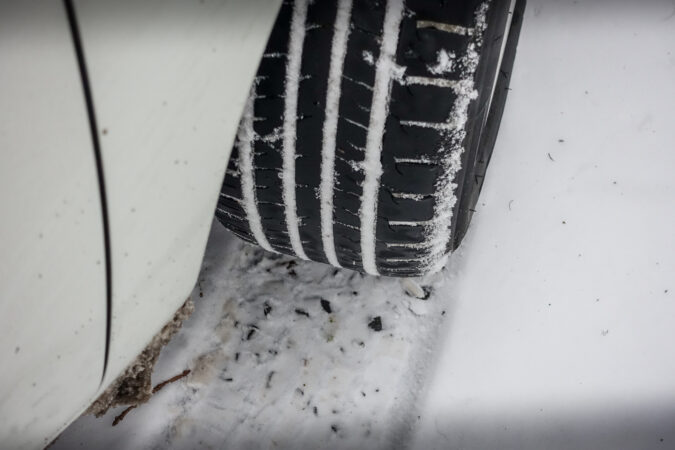Winter is fun but can be messy. It is a time of the year when you will realize that it is not so easy to keep your car on the road for as long as you want to. Your car tires can barely move over the snow, except you provide extra friction using tire socks for snow or snow chains.
Tire socks for snow are custom-fit to your vehicle’s tires, so they’ll fit perfectly and stay on. The snow socks are made of durable rubberized fabric that’s soft and flexible for easy installation yet strong enough to withstand the roughest winter weather.
However, tire socks are not very reliable because they are fabrics. They easily tear, and you may need new ones next winter. Nonetheless, we’ll discuss the snow socks and other alternatives you can use when driving in snowy road conditions.
Snow Socks For Tires
Snow socks are an inexpensive way to protect your car’s tires from winter weather. They are used to cover a tire to enable it to roll well in snow.
A snow sock is a knitted fabric design stretched over the tire to keep snow and ice from building up on your tires. Snow socks come in different sizes, so measuring the height of your tire before selecting a pair is essential.
They are easy to install and remove and can be stored in an empty container when not in use. Some snow socks come with only one opening that can cover both your car tires and the wheel, while some are in the form of two gaps with elastic on both ends.
Despite the differences in design, all snow socks perform the same function. Their only weakness is their lifespan; they are fabrics and tear quickly.
Snow Chain VS Cable
Snow chains and cables help vehicles get through snow-covered roads. They’re also very similar in appearance. However, there are a few differences between the two that make them more suitable for different types of vehicles.
Cable tire chains differ from snow chains in two ways: They are lighter than snow chains because fabricators use weightless metal coils to produce them. Unlike snow chains (heavy steel), cables are easier to use because they do not require installation.
Although snow chains are more durable, their weight can also damage your car tires. Asides from damaging your car tires, they can damage the road if you use them on a dry surface.
Tire Socks For Snow: What Are Snow Chains
Snow chains are tire chains that fit over the tires and provide extra traction when driving in snowy conditions. They have metal links that latch onto each other and wrap around a tire’s treads.
The links are adjustable so that they can fit the different sizes of tires. These devices have many small loops of steel that you attach to your car tire through hooks on one end and pins on the other that fit into holes in your tire treads.
Snow Tires VS Chains
Snow tires have different tread patterns and rubber compounds than the all-season or summer tires that come with your car. Those tread pattern designs make it easy for your car tire to bite into snow and ice. The rubber compounds help the tires to remain flexible in cold temperatures.
Snow tires provide better traction than summer tires on slick, snowy roads. But they’re not magic. They won’t help you stop any faster, and they won’t reduce hydroplaning risk. Also, they wear out quickly and do not provide enough pressure that makes the car tires roll smoothly in the snow.
Snow chains, however, are a durable and reliable pick. A good set of snow chains will help you confidently conquer any snow-covered road or trail. They’re available for cars, trucks, and SUVs, and they can be used on all four wheels or just two, depending on your vehicle’s make and model.
Are snow tires worth it? The answer may be yes, depending on where and how often you drive in snow conditions. However, in a difficult road situation, opt for snow chains because their level of withstanding pressure is higher than that of snow tires.
Snow Socks VS Chains
Snow socks are a good choice, but they provide less traction for your car tires during the snow. One of the disadvantages of using a snow sock in winter is that it cannot take you beyond 20 – 30 miles per hour which makes them unreliable.
Snow chains are heavy steels put on a car tire. This steel provides traction a car tire needs to enable it to roll well in the sow. Unlike snow socks, snow tire chains can take you as far as 50 miles per hour.
Manufacturers use heavy steel that does not wear out fast to produce snow chains. Hence, they function better in snowy weather conditions and provide maximum protection for your car tires. So when you want to make a pick for your car tire, snow chains are better options than snow socks.
Tire Traction Devices
Traction devices are tools that help a driver to get an easy grip on the road while driving in weather conditions like snow or mud. It helps put resistance between the ground and the car. When the resistance occurs, it becomes easy for the car tire to roll freely.
Tire traction devices are one of the best alternatives to snow socks. They are in different forms like socks, rope, or mat. However, when your car gets stuck in the mud or snow, the best traction device to use is the mat.
Snow Chain Alternatives
Snow chains are durable and reliable. But, if you do not have a chain, there are other best cover alternatives you can choose for your car.
Tire Socks For Snow: #1. Snow Socks
This car tire cover is a product of fabric. They are less expensive and easy to use. However, like every other car tire cover for snow, it has pros and cons.
Pros With Tire Socks For Snow
- Snow socks do not damage the car tire because they are fabrics.
- They are easy to wash and reuse.
- They are more affordable.
Cons With Tire Socks For Snow
- Snow socks tear off quickly like every other fabric.
- Using snow socks will not permit you to drive beyond 30 miles per hour.
- They are not durable and reliable.
Tire Socks For Snow: #2. Snow Rope
Snow ropes work the same as snow chains, but the only difference is that it is not steel. They are affordable and easy to find but can easily cut off if not handled properly. You can avoid that problem by buying a thick and strong rope.
Types of Tire Chains
Snow chains come in two categories – automatic and manual. If you prefer using a snow chain often for your car tire, then it is best to choose the one that functions automatically. If you prefer to switch the types of covers you use, opt for the manual chain you can fix and remove yourself.
Manual chains are very economical because they allow you to change your tire covers whenever possible. But for automatic chains, you cannot easily change them. And also, the more you use it, the more it forms a part of your car tire because it tightens as you drive or roll the tires.
One of the automatic types of chain that is very durable and reliable is the Peerless Auto–Trac. They are a product of manganese steel, and the diamond design gives room for it to have a solid grip on the tires while driving.
Peerless Auto-Trac makes less noise and makes the ride comfortable. Asides from enabling your car tire to roll well in the snow, it is also suitable for mud and icy grounds.
Tire Chains Cost
The accurate cost of snow tire chains depends on the type suitable for your car tire. On average, tire chains cost $40 – $60. In total, you can spend up to $300 to purchase tire chains for all four tires.
The prices of tire chains vary. Depending on your car, some can be cheap or expensive. In extreme cases, you will spend $450 – $1000 to buy the best chain for your car tire.
Winter Driving: Snow Socks vs Snow Chains – Need-to-know Facts
- Snow socks are an inexpensive alternative to snow chains, costing around $80 to $90.
- Snow socks are easier to install than snow chains, reducing the amount of time you will be out in winter weather.
- Snow socks won’t cause any damage to your driveway or the road while driving.
- Snow socks work great on low-profile tires and vehicles with low clearance and require very little space.
- Snow socks are made of polyester fiber, which absorbs water off the road surface and improves traction.
- Snow socks are machine washable, making them easy to clean and maintain.
- Snow chains are generally more expensive than snow socks, with a high-quality set costing around $100-150.
- Snow chains generally have superior traction to snow socks and are proven to work on all vehicles.
- Snow chains can be tricky to install, and if not stored correctly, they can get tangled.
- Snow chains are the best option for driving in deep snow and on ice, while snow socks are better for use on very little snow and for those who are concerned about potentially damaging their vehicle.
FAQs On Tire Socks For Snow
Here are some popular FAQs:
How To Put Chains on Tires
Putting chains on your car tire will help provide the pressure the tire needs to roll easily on the snowy or muddy ground. Snow chains come in different forms and sizes, and fixing them to the tire will depend on the size and structure of your car tire. Once you have your chains, lay them on a flat surface and pick each end. If it is an automatic chain, just put it on the tire, roll your tire a bit forward, then lock the chain. If it is a manual chain, gently tie it around the tire till it gets to the end that you will double tie or lock with a padlock.
What Are Traction Tires
Traction tires have molds that make it easy for them to roll in the snow or mud. Are traction tires another best alternative for snow chains, cables, and ropes? Yes. The reason is that traction tires have molds on them. These molds act as a resistance that offers traction between the car and the ground, making it easy for your car tire to roll in the mud or snow. It doesn’t matter if your car is the best model because, without enough pressure on the tires, the car will not move. Before winter, you can easily replace your car tires with traction tires and feel satisfied that you have a more permanent solution to last till the snow season is over. One of the best advantages of traction tires is that they are durable and cost-effective.
How Fast Can You Drive With Snow Chains
20 – 50 miles per hour is the maximum speed you can drive with snow chains on your car tires. This limited speed indicates that you can only use snow chains in snowy and muddy road conditions. Please note that even if you use snow chains on a ground full of snow, it cannot go beyond 50 miles per hour. Snow tire chains cannot withstand the snow pressure for a longer distance. If you force it to go beyond 50 miles per hour, the pressure can cause your steering to break while in motion. So, I advise that you always try to stay within the required mile limit.
What Kind Of Chains Do You Need For The Snow
There are different types of snow chains, but if you want to choose the best chains for your car tire during winter, first consider the structure of the tire your car has. Knowing your car tire type will help you determine the type of chain that will work effectively for your car tires. The different types of snow chains are in two categories – the manual and the automatic. Manual snow chains are less expensive, while automatic chains are expensive. Using manual chains will require that you fix it to the car tire by yourself. The maximum you can drive with them is 15 miles. After 15 miles, you will have to stop and refix them to the car. Meanwhile, automatic chains adjust and fit the car tire as you drive. However, knowing if your car tire requires manual or automatic snow chains will depend on the tire structure.
How Much Are Snow Chains
The prices of snow chains differ. It could depend on the tire type or structure. An average snow chain costs $30 – $70. But, an automatic chain costs up to $80 – $150. If your car is a four-wheel drive, you will spend up to $300 to buy snow chains because you have to cover each tire with snow chains. So, to know the accurate price of snow chains for your car tire, first, consider checking the structure of your car tire. Once your car tire structure, measure it to know the size. For instance, If the size is 80 inches, you will also buy a chain that is 80 inches.
How Do Snow Chains Work
The winter season is usually cold. This cold does not only affect humans but also affects car tires. During this period, snow chains provide traction for car tires and make it easy for them to roll in the snow. During winter, car tires tend to become so cold and stiff. So, when you wrap a snow chain around the tire, it increases the pressure the car tire needs to roll well and makes driving in the snow comfortable. You cannot use snow chains on a dry road. The reason is that it will damage your car tires and the road in extreme cases. You can only use Snow chains in snowy, icy, or muddy road conditions.
Why Do Semis Have Spikes On Their Tires
Semis have spikes on their tires because they serve as a protective shield for vehicle tires. These spikes on the semis protect the tire wheels from getting damaged quickly. Apart from protecting the tire wheels, it helps keep the tire on the track. Spikes function well on trucks that are known to have blind spots by the sides. Due to these blind spots, manufacturers introduced tire spikes to protect the wheel. Aside from protection, they keep the tire on the track. Tire spikes also serve as a guide to the drivers and passersby.
What Size Snow Chains Do I Need
Snow chains come in different sizes and forms, and the size you need depends on the type of tire your car has. One chain size cannot fit all tire types, and an average car tire size is 225. When you want to buy a snow chain for your car tire, ensure that you know the size and structure of your tire so you will not make a mistake. Snow chains are not specific. Their size depends on the size of your tires.
Do Chains Help On Ice
Snow chains are not only efficient on snow. They also provide pressure for car tires stuck on ice and mud. They act as the protective layer your tire needs to roll out from a muddy or snowy surface. Snow chains are heavier and thicker because they are of heavy steel. So, just as they provide the traction your tire needs to roll easily in the snow, snow chains do the same on a surface full of ice and mud.
How To Put On Snow Cables
Before you put snow cables on your car tire, ensure that you know the accurate size of your car tire. Knowing the correct size will help you choose a snow cable suitable for your tire. Once you have sorted out the type of chain your tire needs, carry out the following steps to effectively install snow cables on your tire: Untangle the snow cable and lay it on a flat surface. Pick one end and place it on the top of your tire. Gently wrap it around your tire in a zig-zag fashion until it reaches the other end of the snow cable. Roll your tire forward so you can put the snow cable under it. Once it gets to the end, hold and tie both ends together.
Are Snow Socks Legal In California
Yes, Californians are allowed to use snow socks as a traction device in California. Although you cannot compare the quality of snow socks to that of chains, Californians have permission to use snow socks. However, this permission is limited because they can only use it if snow chains are unavailable. The reason is that snow socks are fabrics that can tear easily. Unlike snow socks, chains have heavy steel that makes them durable. So in California, you cannot use snow socks if chains are available.
Where Can I Rent Snow Chains
You can rent a snow chain. Renting a snow chain is affordable and cost-effective because you do not have to go through the stress of buying a new one. Snow chains are not regular covers for tires. You can only use them during winter. So, this makes renting a good alternative during winter.
When To Use Chains On Tires
You can only use snow tire chains on tires during winter or on roads that are icy and muddy. It is not advisable to use snow chains on dry roads. The reason is that they can only provide traction for your car tire to roll easily on a snowy or muddy road. If you use snow chains on a dry surface, asides from tearing your car tires, it can damage the road.
Are Low Profile Tires Good In Snow
Although low-profile tires are not reliable, they are good in snow. During winter, knowing the structure of your car tire is one thing and knowing its efficiency is another. But, you do not have to worry because even though you use a low-profile tire for your car, it can still be efficient in the snow. Low-profile tires are a product of soft rubbers that enable them to stay on the road while in the snow. Due to their softness, most low-profile tires do not work efficiently in the snow because they tear quickly. So, to ensure that you do not face disappointment, use low-profile tires as a backup tire. However, despite being less efficient, low-profile tires have an advantage. The advantage is that they help increase car speed. They also make driving smooth in the snow.
How To Measure Tire Chains
Place your tape on the body of the chain and measure the length, then switch and measure the width. To measure the length, run the tape vertically from one end of the chain to the other. Then, to measure the width, turn the measuring tape and place it horizontally on the body of the chain. Please note that your tire chain measurement should be the same as the tire. If you increase or reduce the measurement result, the chain will not fit perfectly on the tire. For instance, if your tire size is 70 inches, the chain should also be 70 inches so the chain will fit perfectly.
Conclusion On Tire Socks For Snow
Tire socks for snow are a good choice because they provide the traction your tire needs to stay in the snow, but they are not reliable and durable. The reason tire socks are not reliable is that they are fabrics that can tear quickly. So, in winter, it is best to always opt for more durable traction tools like a mat, chains, or rope that will last longer and offer maximum protection.




